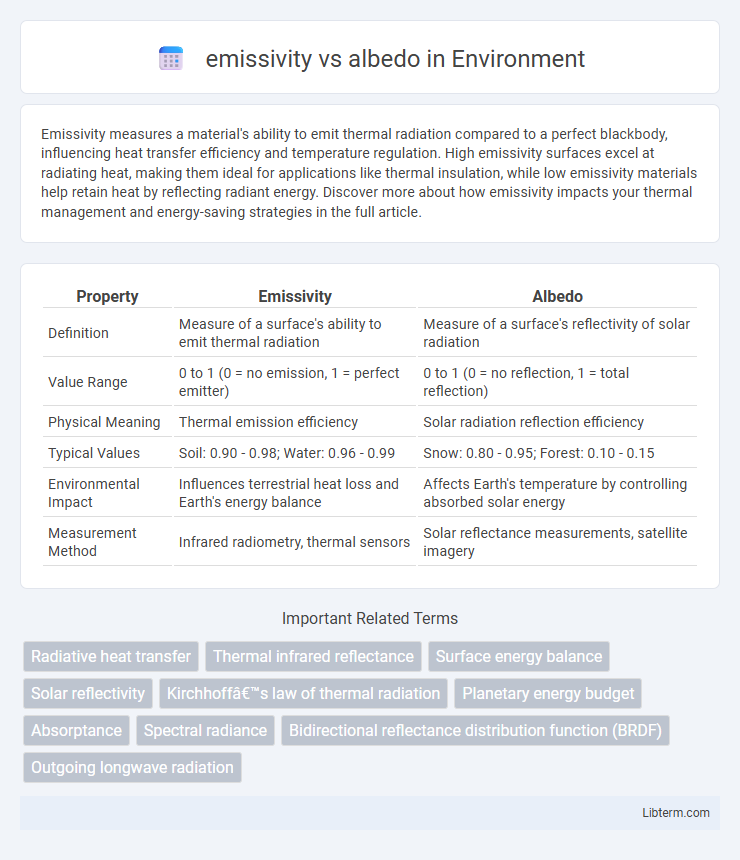Emissivity measures a material's ability to emit thermal radiation compared to a perfect blackbody, influencing heat transfer efficiency and temperature regulation. High emissivity surfaces excel at radiating heat, making them ideal for applications like thermal insulation, while low emissivity materials help retain heat by reflecting radiant energy. Discover more about how emissivity impacts your thermal management and energy-saving strategies in the full article.
Table of Comparison
| Property | Emissivity | Albedo |
|---|---|---|
| Definition | Measure of a surface's ability to emit thermal radiation | Measure of a surface's reflectivity of solar radiation |
| Value Range | 0 to 1 (0 = no emission, 1 = perfect emitter) | 0 to 1 (0 = no reflection, 1 = total reflection) |
| Physical Meaning | Thermal emission efficiency | Solar radiation reflection efficiency |
| Typical Values | Soil: 0.90 - 0.98; Water: 0.96 - 0.99 | Snow: 0.80 - 0.95; Forest: 0.10 - 0.15 |
| Environmental Impact | Influences terrestrial heat loss and Earth's energy balance | Affects Earth's temperature by controlling absorbed solar energy |
| Measurement Method | Infrared radiometry, thermal sensors | Solar reflectance measurements, satellite imagery |
Understanding Emissivity and Albedo
Emissivity measures a material's ability to emit thermal radiation, ranging from 0 to 1, where higher values indicate greater heat emission efficiency, crucial for energy transfer and temperature regulation. Albedo quantifies the reflectivity of a surface, also between 0 and 1, indicating the fraction of solar energy reflected back into the atmosphere, which significantly affects climate and surface temperature. Understanding the distinction between emissivity and albedo helps optimize thermal management in building materials, climate modeling, and planetary science by balancing absorbed, emitted, and reflected radiation.
Key Differences Between Emissivity and Albedo
Emissivity measures a surface's efficiency in emitting thermal radiation, ranging from 0 to 1, while albedo represents the fraction of solar radiation reflected by a surface, also expressed between 0 and 1. Emissivity directly impacts heat loss through infrared radiation, critical in thermal regulation processes, whereas albedo influences the amount of sunlight absorbed or reflected, affecting climate and temperature. The key difference lies in emissivity governing emitted infrared radiation and albedo controlling reflected solar radiation, both crucial for understanding energy balance in environments.
How Emissivity Influences Heat Absorption
Emissivity measures a material's ability to emit absorbed heat as infrared radiation, directly impacting its thermal equilibrium and heat retention properties. Surfaces with high emissivity radiate heat efficiently, leading to faster cooling, whereas low-emissivity materials retain heat by radiating less energy. Unlike albedo, which quantifies reflected sunlight, emissivity governs how effectively absorbed thermal energy is released back into the environment.
The Role of Albedo in Solar Reflection
Albedo is the measure of a surface's ability to reflect solar radiation, significantly influencing Earth's energy balance by determining how much sunlight is reflected back into space. High albedo surfaces, such as ice and snow, reflect most solar radiation, reducing heat absorption and cooling the planet's surface. Emissivity, on the other hand, refers to a material's efficiency in emitting thermal radiation, affecting heat loss rather than the reflection of incoming solar energy.
Measuring Emissivity and Albedo: Techniques and Tools
Measuring emissivity involves using devices like emissometers or infrared thermometers calibrated against known standards to assess a material's efficiency in radiating energy. Albedo measurement typically employs satellite imagery and photometric instruments to quantify the reflectance of surfaces, expressed as a ratio of reflected to incident solar radiation. Advanced tools such as spectroradiometers and goniometers further enable precise spectral and angular assessment of both emissivity and albedo for varied applications in climate science and material analysis.
Surface Materials and Their Emissivity vs Albedo Values
Surface materials exhibit distinct emissivity and albedo values that critically influence thermal radiation and solar reflectance properties. Dark surfaces like asphalt typically have low albedo (0.05-0.20) but high emissivity (0.85-0.95), absorbing more solar radiation while efficiently emitting thermal energy. In contrast, light-colored materials such as concrete and snow display high albedo (0.6-0.9) with generally lower emissivity (0.7-0.9), reflecting more sunlight yet emitting less longwave radiation.
Emissivity and Albedo in Climate Science
Emissivity measures a surface's efficiency in emitting thermal radiation, playing a crucial role in Earth's energy balance by influencing heat loss to the atmosphere. Albedo quantifies the reflectivity of surfaces, determining how much solar radiation is reflected back into space, thereby affecting global temperature and climate patterns. Both emissivity and albedo are key parameters in climate models for accurately simulating surface energy exchanges and predicting climate change impacts.
Applications in Building Design and Energy Efficiency
Emissivity and albedo critically influence building design by affecting thermal performance and energy efficiency; high-emissivity materials enhance radiant heat loss, reducing cooling loads, while high-albedo surfaces reflect solar radiation, minimizing heat absorption. Utilizing low-emissivity coatings on windows and reflective roofing materials optimizes indoor temperature control, leading to significant reductions in HVAC energy consumption. Integrating these properties into architectural elements supports sustainable design strategies and compliance with energy codes aimed at reducing building carbon footprints.
Challenges in Comparing Emissivity and Albedo
Challenges in comparing emissivity and albedo arise due to their distinct physical properties and measurement conditions; emissivity quantifies a surface's efficiency in emitting thermal radiation, while albedo measures reflectivity of visible light. Variability in surface texture, angle of incidence, and wavelength dependence further complicate direct comparisons, as emissivity often depends on infrared wavelengths whereas albedo pertains primarily to solar spectrum reflectance. Accurate assessment requires controlled environmental conditions and spectral-specific instruments to isolate these properties for meaningful analysis in climate and energy studies.
Emissivity and Albedo: Implications for Future Research
Emissivity measures a material's ability to emit thermal radiation, while albedo quantifies the reflectivity of a surface, impacting energy balance and climate models. Understanding the interplay between emissivity and albedo is crucial for improving satellite observations and enhancing climate prediction accuracy. Future research should prioritize developing advanced materials and measurement techniques to better quantify these properties across diverse environments.
emissivity Infographic

 libterm.com
libterm.com